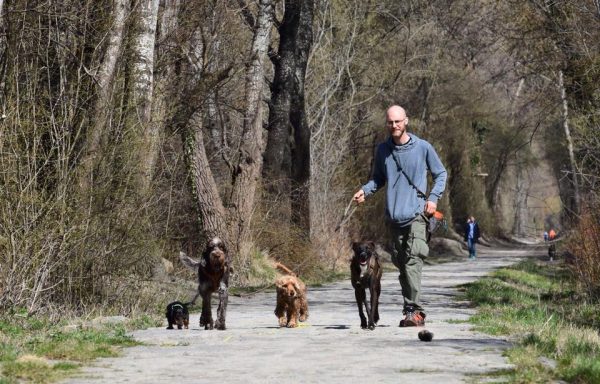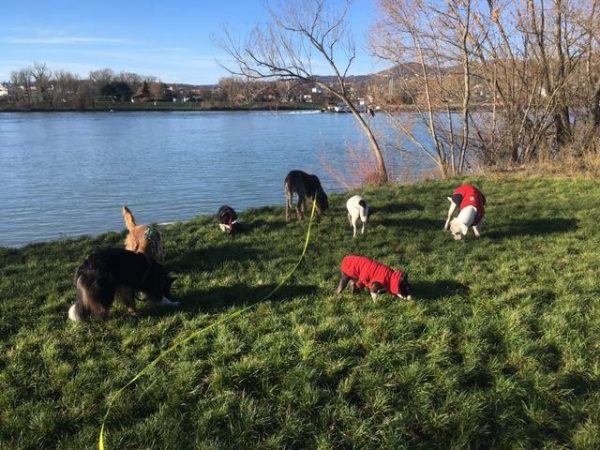I know that walking a dog that pulls on the leash, jumps around and barks can be exhausting and frustrating. But trust me, they are not doing it to spite you. Contrary to what we like to believe, many dogs struggle with interactions with their peers, especially if they are on the leash1. In this post, we will explore the main reasons behind this problem and look at possible solutions.
At the same time, every situation is different, and this can be a tricky issue to train so it is always best to contact a competent, non-violent dog trainer who can help you personally.
Causes
In general, dogs “overreacting” to other dogs are mostly motivated either by fear or by excitement. In both cases the problem is the inappropriate level of arousal: the dog is not in control of their actions which also means they can’t listen to us then.
Just like people, dogs need to learn social skills and the experiences they make when they’re young can determine their behaviour later on2. Other contributing factors are their personality, stress levels, age and health. While you can’t change your dog’s personality or age, you can make sure that they’re healthy and not stressed out.

© Heide Klinger/Donau Dogs
What does your dog really want?
One of the most important things to remember is that each behaviour serves a purpose and it is crucial for us to recognize what that purpose is.
- A dog that loves playing with other dogs probably pulls on the leash (or barks or jumps) because they learned that their human will eventually give up and let them approach.
- A dog that is fearful has probably learned that pulling, barking and jumping makes the other dogs go away.
Basically, they are trying to either decrease or increase the distance to the other dogs. They behave the way they do because it was a successful strategy and we “simply” need to teach them a different one.
Recognizing your dog’s motivation is key for further training because it will determine the reinforcement you use. In these situations typically food or play can be used to help the process along but your dog can only be efficiently rewarded with something that they want in a given situation (that is: getting closer to or further from the other dog) 3.

© Heide Klinger/Donau Dogs
The vicious circle of arousal – do not punish!
As I have mentioned above, the main issue is that your dog is too aroused to control their own actions. Regardless of their motivation, further increasing the arousal level will only make the situation worse. Shouting, jerking the leash, smacking your dog (or any other aversive action) will not make your dog calm down. What they can achieve is:
- increase your dog’s stress level
- make them fear you
- destroy their trust in you
- make them less likely to want to be close to you – which is the opposite of what you want in this situation
Aversive trainers often claim (quick!) success with their methods. But what they do is behaviour suppression, not behaviour modification. Many of these dogs either get more and more stressed out until they snap and “bite out of nowhere” (sounds familiar?) or they fall into the state of learned helplessness. 4 I can’t imagine you want any of that for yours.

© Heide Klinger/Donau Dogs
Ok, so what can I do?
BEFORE THE WALK:
- learn to read canine body language, so that you can assess your dog’s emotional state, as well as the other dogs that you meet
- train only in situations that you can control – your dog can only train when they’re not too excited
- invest in a harness – constant pulling on the leash while wearing a collar can lead to tracheal damage; the dogs pulling and wheezing are not suffering from asthma, they just have trouble breathing.
- eliminate as many stressors as possible from their life – have a look at your dog’s routine: do they get enough of down time? are there other things that freak them out? is their day predictable enough to feel safe? (learn more about relaxed and yet engaging walks)
DURING THE WALK:
- remain calm – it’s easier for your dog to keep their cool if you keep yours
- always have treats on you – if your dog is into food you can distract them before they notice the other dog- drop the treats early enough and they might just focus on them instead of freaking out5
- support your dog – if they are fearful help them maintain a safe distance from other dogs
- make sure all interactions are chill and positive – if you have the “lovingly-excited” dog you don’t want to prohibit all interactions with dogs, which would be punishing. Instead, find a friend or two with calm, well-socialized dogs and hang out with them, or join a social walk organized by a competent trainer.
- always tell your dog when they’re doing well. here is a list of behaviours you can reward:
- slowing down
- approaching other dogs in a bow
- looking away
- turning away
- looking at you
- sitting down
- lying down
- sniffing
But what if a dog off-leash approaches us?
The default is: dogs should meet only off leash. If you see someone approaching with a dog on a leash, you should leash your dog too and keep a safe distance. If you keep your dog leashed, the other dog owners should do the same for you. If they are unwilling to do so, you can resort to these two tricks:
- You can stop the approaching dog by throwing a lot of yummy treats – make sure that they can see it, make a fuss if needed. More often than not, the dog will pause to retrieve free food and you can quickly retreat.
- You can motivate the owner to respect your request and leash their dog/move away by telling them… that your dog has fleas or other parasites. Seriously.
When off-leash, dogs can communicate clearly: Leus (on the left) approaches the other dog in a curve, a little tensely. The dog sprints at her, she jumps so that they stand in opposite directions and turns her head away. Tension dissolved, the other dog gets re-called and both dogs shake themselves off.
Myths
Last but not least, let us look at four common myths that might be slowing your progress:
Your dog pulls because they’re dominant and trying to control the situation – NOT TRUE
Quite the opposite, it’s a sign that they’re overwhelmed.
A harness will make your dog pull more (because they won’t be “corrected” [=punished] for doing so) – NOT TRUE
You really can’t do anything wrong by looking out for your dog’s health; also, the tightening collar restricts access to oxygen, which in turn increases arousal (stress) instead of decreasing it.
All dogs love playing with each other – NOT TRUE
Watching dogs play is a delight but studies of free roaming dogs have shown that adults dog rarely engage in play. Like people, dogs are individuals and vary in their sociability.
You should never pick up a small dog – NOT TRUE
You should learn to evaluate when your dog needs help and when they don’t. Let them handle as many situations as they can but if it’s too much, by all means do pick them up, this way they’ll know you’re on their side.
